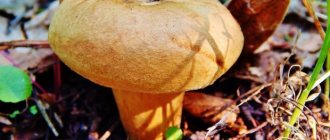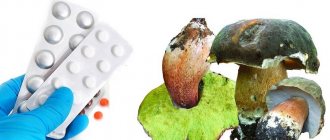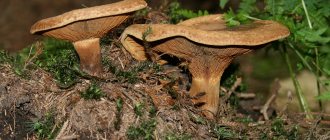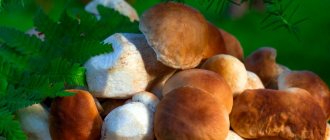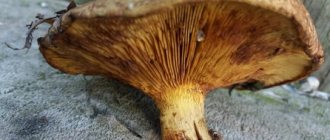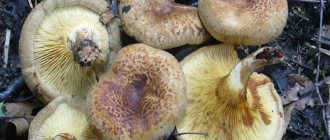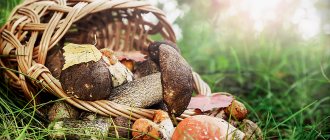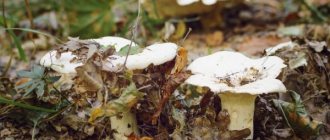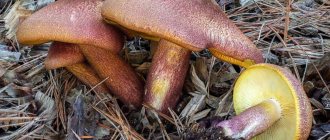Svinushka mushroom (also known as barnyard, pig's ear, pig's ear, havroshka, dunka, fetyukha) - includes both conditionally edible and poisonous varieties of fruiting bodies. The culture belongs to the pig family and literally translates as “small bag”. It is found throughout our country, mainly in regions with a temperate climate. As a rule, mushroom pickers prefer to avoid suspicious fruits that resemble the heels of livestock, but there are also those who put their finds in a basket and then look for information on the use of the product.
Today we will study what pig fruits look like, consider its edible and dangerous varieties, and also discuss the benefits and “treachery” of the plant.
Description
The cap is fleshy and thick, 4-15 cm in diameter. In a young specimen it is knitted, arched with a wide convex arch, with a strongly curled fluffy edge. Becomes looser, flat-convex, or arches toward the center over time. Velvety to the touch, rough or smooth, sticky when damp and dry when it’s dry outside, finely pubescent. Color ranges from brown to tan, olive or grayish brown.
The hymenophore is narrow, densely packed, separated in layers, descends down the stalk, becoming convoluted or pore-like near the stalk. Color ranges from yellowish to pale cinnamon or pale olive. When damaged it turns brown or reddish brown.
The stalk is 2-8 cm long, up to 2 cm thick, tapers towards the base, there is no veil, dry, smooth or thinly pubescent, colored like a cap or paler, and when damaged changes color from brownish to reddish-brown.
The body of the mushroom is thick, dense and hard, yellowish in color, turning brown when exposed.
The taste is sour or neutral. It does not have a characteristic fetor, sometimes the mushroom smells damp.
Fried with potatoes
Required:
- Svinushki – 200 gr.
- Potatoes – 300 gr.
- Onions – 2 pcs., medium size.
- Garlic – 3 cloves, medium size.
- Butter – 50 gr.
- Vegetable oil.
- Cheese – 100 gr., hard varieties.
- Black pepper, salt and herbs - to taste.
Cooking:
- Fry the fruit bodies in a frying pan in vegetable oil, along with the onion, cut into cubes, for 10 minutes.
- Add sliced potatoes to the pan and simmer over low heat until tender, adding a little water if necessary and stirring.
- Sprinkle the finished dish with grated cheese, season with butter and herbs. If desired, you can add sour cream.
Types of pigs
Paxillus atrotomentosus (fat pig)
The widely known mushroom has a hymenophore, but is part of the Boletales group of porous mushrooms. Tough and inedible , it grows on conifer stumps and rotting wood and contains several compounds that prevent insects from eating it.
The body of the fruit is squat with a brown cap up to 28 cm in diameter, with a curled edge and a depressed center. The cap is covered with a dark brown or black velvety coating. The gills of the mushroom are creamy yellow and forked, the thick stalk is dark brown and grows away from the mushroom cap. The pulp of dunka is appetizing in appearance and is little affected by insects. The spores are yellow, round or oval and 5-6 µm long.
This saprobic fungus is favored by the stumps of coniferous trees in North America, Europe, Central America, eastern Asia, Pakistan and China. The fruiting bodies ripen in summer and autumn, even during drier periods when other mushrooms do not grow.
Pigweed mushrooms are not considered edible , but they have been used as a food source in parts of Eastern Europe. Tests on the chemical composition and free amino acid levels of the mushrooms indicate that they are not significantly different from other edible fried mushrooms. Young mushrooms are reported to be safe to eat, but older ones have an unpleasant bitter or inky taste and are possibly poisonous. The bitter taste is said to go away by boiling the mushrooms and discarding the used water. But not all people digest the product even after heat treatment. European gastronomic literature reports cases of poisoning.
Slender pig (Paxillus involutus)
The basidiomycete fungus is widespread in the Northern Hemisphere. It was unintentionally introduced to Australia, New Zealand, South Africa and South America, probably transported in soil by European trees. The color is various shades of brown, the fruiting body grows up to 6 cm in height and has a funnel-shaped cap up to 12 cm wide with a characteristic curled rim and straight gills, which are located close to the stem. The mushroom has gills, but biologists classify it as a porous mushroom, and not a typical hymenophore.
The thin pig is common in deciduous and coniferous forests, in grassy areas. The ripening season is late summer and autumn. Interactions with a wide range of tree species are beneficial for both species. The fungus consumes and accumulates heavy metals and increases resistance to pathogens such as Fusarium oxysporum.
Previously, thin pig was considered edible and was widely eaten in Eastern and Central Europe. But the death of the German mycologist Julius Schaeffer in 1944 forced us to reconsider our attitude towards this type of mushroom. It has been found to be dangerously poisonous and cause stomach upset when eaten raw. Recent scientific experiments have shown that thin pig causes fatal autoimmune hemolysis even in those who have consumed the mushroom for many years without any other harmful effects. The antigen in mushrooms triggers the immune system to attack red blood cells. Serious and fatal complications include:
- acute renal failure;
- shock;
- acute respiratory failure;
- disseminated intravascular coagulation.
Panus-shaped or ear-shaped pig (Tapinella panuoides)
Saprobic fungus grows singly or in clusters on dead coniferous trees, sometimes on wood chips. It bears fruit from late summer until the first frost, as well as in winter in warm climates.
The brown/orange, shell or fan-shaped cap (2-12 cm) of a young pig is hard, has a rough surface, but with age it becomes smooth, flaccid, the orange gills become curled or corrugated at the base. The mushroom darkens slightly when cut. The mushroom does not have a stalk, but only a short lateral process that attaches the cap to the wood.
The odor is faint to aromatic resinous, the taste is not distinctive. The wonderful mushroom smell attracts people, as does the external resemblance to oyster mushrooms, but the ear-shaped pig is not edible.
Hymenophores with smooth edges, located closely, relatively narrow. They arise from the point of basal attachment and appear wrinkled when viewed from above, especially in old mushrooms. The gills sometimes bifurcate and appear porous in a mature mushroom and are easily separated from the cap. The color of the hymenophore ranges from cream to dark orange, from apricot to warm yellow-brown, unchanged when damaged.
Spores: 4-6 x 3-4 µm, broadly ellipsoidal, smooth, with thin walls. The spore print is brown to pale yellow-brown.
Alder pig (Paxillus filamentosus)
A very dangerous species due to its toxicity. Funnel-shaped, the same as that of saffron milk caps, but with a brown or yellowish-ocher color, with a soft texture and, in general, the entire hymenophore crumbles when manipulated.
Under the cap are thick, soft to the touch and dense gills, sometimes they are slightly sinuous or curly and deviate greatly from the stalk, but do not form pores or a reticulate structure, are yellowish or yellow in color, turning red when exposed.
Minolta DSC
The basidia are cylindrical or slightly expanded, ending in four peduncles, the extremities of which produce yellow-brown or brown spores that darken mature specimens of the fungus. The spores are ellipsoidal, rounded at both ends, with smooth walls, with a thick vacuole.
The cap has a smooth surface, which in older alder pigs breaks into fibers, especially towards the curled or wavy edge, and is light brown or ocher-yellow in color. When manipulated, the cap turns brown.
The surface of the stalk is smooth, light brown, also turns brownish when exposed and has light pink mycelium.
The alder pig lives in deciduous forests, hiding among alders, poplars and willows. The mushroom is especially dangerous and causes fatal poisoning.
Where does it grow
The mycorrhizal fungus lives among a wide variety of deciduous and coniferous trees. Also exists as saprobe on wood. It is found not only in forests, but also in urban areas. Grows alone, scattered or in a wide community in summer and autumn.
The pig is widespread in the Northern Hemisphere, Europe and Asia, India, China, Japan, Iran, eastern Turkey, in the north of North America up to Alaska. The fungus is more often found in coniferous, deciduous and birch forests, where it prefers damp places or wetlands and avoids calcareous (chalky) soils.
Where does the pig grow?
Pigweed survives in polluted environments where other mushrooms cannot survive. Fruiting bodies are found in lawns and old meadows, on woody material around stumps in autumn and late summer. Several species of flies and beetles use fruiting bodies to lay larvae. The fungus may be infected with Hypomyces chrysospermus, a type of mold. The infection results in a whitish coating that first appears in the pores and then spreads over the surface of the fungus, turning golden yellow to reddish brown in adulthood.
Seasonality
Pig mushrooms grow in small colonies. This is an early species, appearing from early June and growing until the first frost. There are a maximum number of cowsheds in August-September, especially after rain. Pigs do not have any special preferences for where they grow. It grows in both coniferous and mixed forests with moist soil. Does not tolerate soil saturated with lime (chalky soil). Found in urban areas - on lawns and along roads. Able to survive in polluted industrial areas. It can exist as a saprobe in trees.
Edible or not
Dunki mushrooms were used as food in Central and Eastern Europe until the mid-20th century and did not cause food reactions or poisoning. The mushroom was eaten after salting. In its raw form, it irritated the gastrointestinal tract but was not fatal.
There are still cooks who call for soaking dunki, draining the water, boiling and serving. They even provide various culinary recipes, which apparently were taken from 20th century literature and modified for modern cuisine.
If you think that risk is a noble cause, then do not pay attention to scientific works and deaths that prove that pigweeds are poisonous mushrooms that cause poisoning. There are many other types of mushrooms that also grow in forests, but are safe for humans.
Meat broth soup
Required:
- Mushrooms – 700 gr.
- Potatoes – 5 pcs., medium size.
- Carrots – 1 piece, medium size.
- Onion – 1 piece, medium size.
- Bay leaf – 1 pc.
- Meat broth - 2 liters.
- Salt, pepper and dill - to taste.
Preparing the soup:
- Bring the meat broth to a boil and add grated carrots and diced potatoes. Boil for 10 minutes.
- Add the pork and cook everything until the potatoes are ready. Then add the diced onion and bay leaf and boil for another 5 minutes.
- At the end of cooking, add salt and pepper, and garnish with herbs before serving.
Symptoms of poisoning
In the mid-1980s, physician Rene Flammer from Switzerland discovered an antigen inside the fungus that stimulates an autoimmune reaction that causes the body's immune cells to consider its own red blood cells as foreign and attack them.
A relatively rare immunohemolytic syndrome occurs after repeated consumption of mushrooms. This most often occurs when a person has consumed the mushroom for a long period of time, sometimes many years, and has mild gastrointestinal symptoms.
A hypersensitivity reaction, not a toxicological one, since it is not caused by an actual toxic substance, but by an antigen in the fungus. The antigen has an unknown structure, but stimulates the formation of IgG antibodies in the blood serum. During subsequent meals, complexes are formed that attach to the surface of blood cells and ultimately lead to their destruction.
Symptoms of poisoning appear quickly, initially including vomiting, diarrhea, abdominal pain and an associated decrease in blood volume. Soon after these initial symptoms appear, hemolysis develops, resulting in decreased urine output, hemoglobin in the urine, or outright lack of urine production and anemia. Hemolysis leads to numerous complications, including acute renal failure, shock, acute respiratory failure, and disseminated intravascular coagulation.
There is no antidote for poisoning. Maintenance therapy includes:
- general blood analysis;
- tracking kidney function;
- measurement and adjustment of blood pressure;
- creating a balance of fluids and electrolytes.
Dunki also contains agents that appear to damage chromosomes. It is unclear whether they have carcinogenic or mutagenic potential.
Benefits and harms
The main danger of ear-shaped pig is that the toxins it contains do not lose their properties even after prolonged heat treatment. The pulp of this mushroom contains a special antigen. It binds to human cell membrane structures. As a result, the immune system considers them hostile and begins to attack such cells.
This leads to destruction of red blood cells and subsequent kidney failure. In addition, pigs grow almost everywhere, including in places with poor ecology. Heavy metals and radioactive isotopes accumulate in their pulp, causing serious poisoning.
